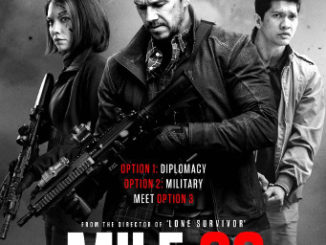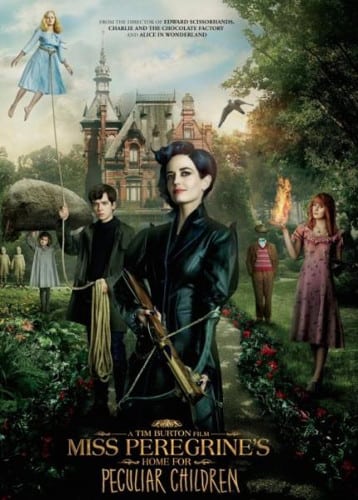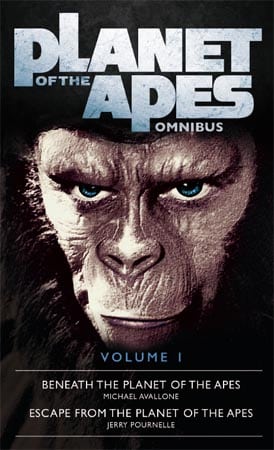Planet of the Apes (2001)
Directed by: Tim Burton
Written by: Lawrence Konner, Mark Rosenthal, Pierre Boulle, William Broyles Jr
Starring: Helena Bonham Carter, Mark Wahlberg, Michael Clarke Duncan, Tim Roth
USA
AVAILABLE ON BLU-RAY, DVD AND DIGITAL
RUNNING TIME: 120 mins
REVIEWED BY: Dr Lenera
MAJOR SPOILERS!

In 2029, aboard the United States Air Force space station Oberon, Leo Davidson works closely with apes who are trained for space missions. When a deadly electromagnetic storm approaches, a small space pod piloted by his favourite ape co-worker Pericles is used to probe it and disappears. Leo takes a second pod and finds Pericles, but inside the storm loses contact with the Oberon and, in 5021 A.D., crashes on a planet called Ashlar which turns out to be ruled by humanoid apes who speak English, use domesticated horses for transportation, and treat human beings as slaves. But then he meets a female chimpanzee named Ari, who protests the mistreatment humans receive, and who decides to buy Leo and a female slave named Daena to have them work as servants in the house of her father, Senator Sandar….

And so, after a much longer break than I originally planned, we come to what was the first Ape film in 28 years, though there was a TV series following the release of Battle For The Planet Of The Apes. When this reboot of the 1968 original was about to come out, Tim Burton was one of my favourite living filmmakers, a director who has a very particular [and influential] style yet who made movies that were aimed as a mass audience and were popular [Mars Attacks being a rare commercial failure]. His run from Pee-Wee’s Big Adventure to Sleepy Hollow didn’t have a weak film in it, and I was very excited to see what he would do with this property. Well the answer was – not very much. I vividly recall the sense of crushing disappointment about a third of the way through when it was very likely that things weren’t going to get much better, in a film which seemed to lack Burton’s touch and not really do much with the premise which was certainly interesting and strange enough to warrant having another go at it. Of course it was good to see the apes act far more like apes this time, and technically it was a marvel. Seen now, it’s a decent science fiction adventure with some good concepts, twists and an ending which might not be as stupid as all that. However, while it does achieve a nice balance between sticking close to the original and doing some different things, it can’t help but be compared badly to the former in other ways, most notably in the way that the script significantly dumbs things down, with only a bit of the social commentary retained and now simpler minded. And we in no way get anything close to the poignancy of the original’s idea of a man who tires of his fellow humans and even hates them, tries to get away from them – and then has his hatred entirely justified. But I’m going to try to not spends too much time on comparing, because there are certainly things to enjoy and appreciate in this 2001 itineration – though seeing all the changes this project went through, one can’t help but make one wish that one of the earlier concepts or scripts had made its way onto the screen instead.
First up was Adam Rifkin’s Return to the Planet of the Apes, an alternate sequel to the original, with a descendant of Heston’s character leading a human slave revolt. Then Peter Jackson and Fran Walsh pitched the apes going through a Renaissance, the humans revolting and the liberal apes sheltering a half-human, half-ape from the gorillas. Roddy McDowall agreed to play the Leonardo da Vinci-type character they’d written for him, but when the executive Jackson spoke to expressed little interest and didn’t even know who McDowall was, he gave up. Then In 1993, Terry Hayes wrote a script based on an Oliver Stone story about a virus killing humans in the future, secret numeric codes to the Bible that foretold the end of civilisation, and a journey to the distant past where humans fought apes for survival. Arnold Schwarzenegger was to star and Phillip Noyce to direct, but Fox’s Dylan Sellers fired Hayes when he refused to put in a comic baseball scene[!], and Noyce walked. Then Fox brought in Chris Columbus, who got Sam Hamm to rewrite the screenplay so that the virus was from another planet. Lots of previously unused ideas from Pierrre Boulez’s novel were used, but Fox still weren’t happy. Jackson was then asked to return with James Cameron as producer but refused, recognising that they’d probably conflict, then was asked a third time when it wasn’t clear that The Lord of the Rings would happen. In 1999, William Broyles Jr’s script was finally greenlit, and Burton signed on along with original producer Richard D. Zanuck, but Lawrence Konner and Mark Rosenthal were doing rewrites even as sets were being constructed. Shooting mostly took place at Sony Pictures Studios in Culver City, California, while locations included Lake Powell, where parts of the original film were shot, the lava plains in Hawaii and Trona Pinnacles at Ridgecrest. It wasn’t good enough a box office success to get a sequel.
After the opening titles showing ape cave-art and armour which certainly get us into the right mindset, along with Danny Eflman’s pounding music with its heavy percussion [though the score as a whole is disappointing, with nothing memorable], we get a bravura opening shot which accurately suggests that in terms of special effects and visuals this film will impress. We’re in space, and we pan down to the sun, then Earth, before a spaceship appears out of the left hand side of the screen, only it’s the interior because what we’ve been seeing has been through a window. We’re now in a cockpit and a chimpanzee is piloting, but then our hero appears in the window because this is a simulator. One thing that’s nice to see in this version is how it establishes, though not in as much detail as it could have done, the relationship between humans and apes, but soon Piracles the chimpanzee is sent first into this electromagnetic storm, even though his trainer Leo says that he should go first because he more knows what he’s doing. Leo then goes away on the next space ship, nobody on the space station seemingly noticing him going to board it, but crashes on Ashlar. The jungle he finds himself in is a good contrast from the desert we saw in 1968, but we get no build up here, Leo suddenly coming face to face with some primitive humans being chased and kidnapped by gorillas in armour, who this time are able to swing suddenly out of trees. The humans include Karubi and his daughter Daene, and Leo is captured too. They’re all taken, via a cart pulled by humans, to a city, and their, and our, introduction to this weird place is nicely dwelt on, with nice little details for us to pick up on. However, what’s truly weird is how little Leo reacts to all this, as if it’s pretty normal. Mark Wahlberg’s extremely “restrained” [that’s being polite though we know from other films that he can give good performances] acting throughout is certainly to the film’s detriment.

Buyer Limbo isn’t particularly impressed with this lot, especially a young boy named Birn because “something you don’t want in your house is a human teenager”, but Limbo’s daughter Ari immediately takes a shine to Leo, and decides to buy Leo and Daena herself, while back in the forest Thade is asked to see something and kills two underlines in excitement. Ari doesn’t like the way humans are treated, even making her feelings known at a dinner where General Thade, who hates humans, wants control and fancies Ari, and his aide Colonel Attar are present. Subtlety isn’t really in evidence, largely replaced with the kind of sledgehammer messaging that’s common these days, with lines like “the humans breed too quickly” and “I think the city has about as much diversity as I cam handle” spoken at this particular scene. Leo soon escapes his cage and frees Daena, Karubi and Birn, and we get a lengthy flight sequence through Limbo’s large, room-filled house which is clearly riffing on the much shorter escape in the 1968 version, but, while that was dramatic and thrilling, this is just long, though we get more fun tiny vignettes showing the lives of apes in this brave new world, such as an old ape removing a wig and false teeth before bed, and a young woman ape, probably a prostitute, dancing before a much older one. Limbo sees the escapees but is taken prisoner to ensure his silence. They journey back to the forest where they discover Calima The Forbidden, the holy temple of Semos, the first ape revered as a god. Thade is told by his dad [Heston] that there was a time where apes were kept in cages or experimented on, even though this isn’t Earth – there’s no eventual revelation that it is. Roth wasn’t happy to learn he was working with gun-loving Heston, so it’s amusing to see Heston give him a really old gun made by humans that he’s kept. Thade goes off and mobilises an ape army.
One of the best portions of the original is when our main protagonists are in the Forbidden Zone and find clues about this strange planet they’re on, leading to that Big Revelation. That formed its climax, back in the day when there wasn’t a need for things to end with a big action scene. We get a comparable section here, though two thirds or the way through, not really containing clues as such but with a similar feel and ending with a revelation of its own which may not be as startling but which is just as important to the story. It reveals that Calima is the remains of the Oberon which had crashed on the planet’s surface and now looks ancient, the name Calima coming from the sign “CAution LIve aniMAls”, the relevant letters being the only ones not covered in dust. According to the computer logs, the station has been there for thousands of years. It seems that Leo was pushed forward in time, while the Oberon, searching after him, wasn’t, crashing on the planet way before he did. It’s a cool concept, but if you think about it, it doesn’t hold as water as might have been hoped for, because the Oberon’s log reveals that the apes on board, led by Semos, organised a mutiny and took over the vessel after it crashed. The human and ape survivors of the struggle left the ship and their descendants are the people Leo has encountered since landing – which is a bit ridiculous really. It would probably have been better if this had been Earth, not some other planet, but then again all this electro-magnetic cloud stuff can be said to cause the ending to make perhaps a bit of sense. Maybe. It seems that the earlier the cloud is travelled through the later in the future you come out the other side. It can therefore be assumed that years after Leo left, Thade followed and therefore appeared several hundred years earlier on Earth, and was able to start an ape mutiny, even though the mindset was more probably “let’s set up a sequel in the most extreme way and we’ll work it out later”.
The design of the Ape’s abodes is less strange-looking, despite this not being on Earth, which weakens the atmosphere, but is maybe more believable; I especially like the bits of vegetation incorporated into seemingly every building. The ape makeup by the expert in this field Rick Baker [replacing Stan Winston due to “creative differences”], is extremely articulate, and the actors in the masks, who had to attend “ape school” for a month to learn to behave like apes, really come through, perhaps most notably an extremely enthusiastic Paul Giamatti as Limbo. Helena Bonham’s makeup as Ari was changed to make it less ape-like, but she ended up looking like a Gelfling out of The Dark Crystal. Her character is chiefly given platitudes to speak rather than proper dialogue, in a film which has a little bit of stuff about freedom, religion and race, but with little of the intelligence we had in 1968, while wit is largely restricted to the human ape reversal [which isn’t as strong as it could be anyway because these humans are intelligent and can speak] and two famous quotes from the original employed ironically. The love triangle of Leo being fancied by both a human and an ape doesn’t go anywhere interesting, despite Ari’s attentions being pretty forward and the suggestion that Leo could be interested, but then again this was a PG-13-rated movie so I guess things couldn’t go too far. Despite possessing elements which are certainly impressive, and not being a bad film really if taken on its own, this Planet Of Tbe Apes feels overly safe, rather blanded down for a mass audience even though the original was commercially intended and a big hit.
Rating: 














Be the first to comment